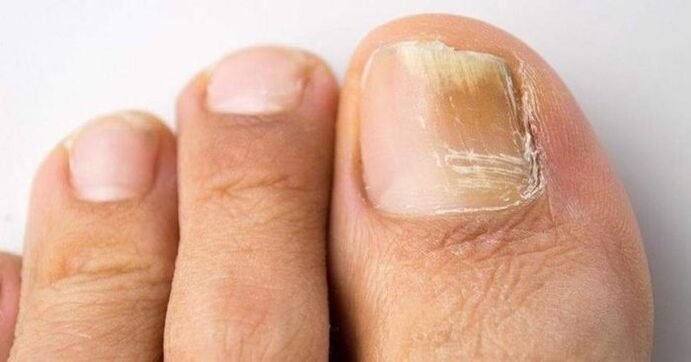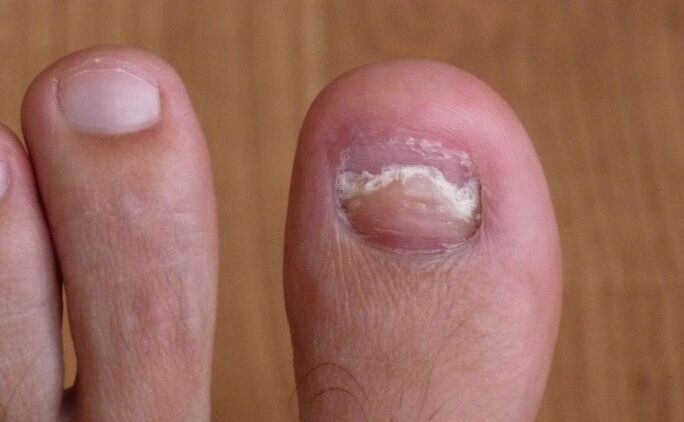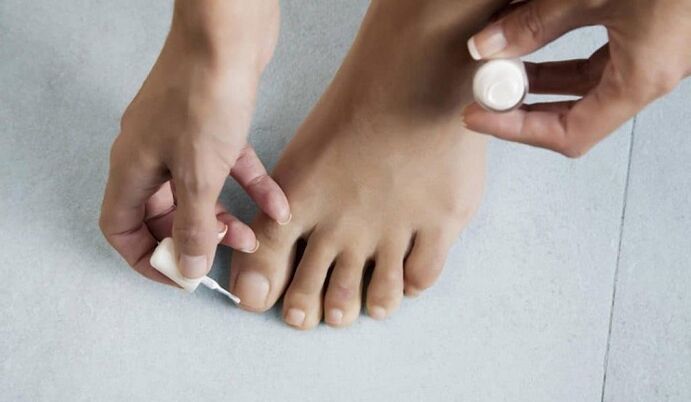Fungal disease can affect various tissues in the body, even internal organs. If the disease has affected the nail, it is called onychomycosis. Its appearance is caused by fungal microorganisms.
They are divided into different genera: candida, molds, dermatophytes. Parasites literally feed on the nail plate, leading to its early destruction. Mycosis itself does not go away. This is only possible with the strongest work of the immune system and the first stage of the disease, when the symptoms are not visible. If signs of illness appear, you can be sure that they will not go anywhere without therapy.

Reasons for appearance
Fungal microorganisms belong to the class of irritants. They are extremely tough. They penetrate quickly into tissues, adapting to different conditions. This is due to the complexity of treating the disease. If you use the same medicine for a long time, the parasites may stop reacting.
The only cause of the disease is the penetration of the fungus into the nail plate. However, there are factors that contribute to its early introduction for later reproduction. Microorganisms are more likely to invade tissues if they have corns. Even dry skin can lead to microcracks through which the fungus can easily penetrate. The microorganism "likes" wet conditions and therefore actively spreads to people who prefer tight shoes made of poor materials that do not allow air to pass through.
Often, toenail fungus occurs in the background of various pathologies:
- Endocrine diseases;
- Psoriasis;
- Varicose veins;
- Vascular diseases;
- HIV and AIDS;
- Problems with metabolic processes;
- Eczema;
- Dermatitis;
- Infectious processes of the skin.
Fungal microorganisms can enter the plate as follows:
- Contact with the carrier of the infection;
- Visiting public baths, saunas, showers;
- Wearing the slippers of others (such as at a party);
- Living with a man with mycosis;
- Shoe testing;
- Use of non-disinfected pedicure devices;
- Visiting beauty salons.
Factors that cause the appearance of mycosis are also:
- Lack of proper personal hygiene;
- Synthetic products are preferred;
- Wearing tight shoes that do not allow the skin to "breathe";
- Excessive obesity;
- Frequent alcohol consumption;
- Old age.
There will be more prominent manifestations of the disease if a person has circulatory disorders in the foot area. The change in acid balance observed while taking antibiotics can also lead to pathological processes.
Stages of the disease
The surface under the nails is very favorable for the growth of fungal microorganisms. It contains many of the nutrients from which parasites feed. Gradually, due to the action of bacteria, the nail plate dies. Cavities begin to form in which the mycelium of the fungus multiplies. There are the following stages of the disease:
- The initial.It refers to the type of normotrophic damage. The main damage affects the center or edge of the disc. Spots and streaks appear that begin to grow gradually;
- Average.It means hypertrophic changes. This stage is characterized by the thickening of the nail, the change of its structure and growth direction. Abnormal processes gradually spread throughout the disc;
- Dystrophy section.The listed processes cause inflammation in the area of the nail drive. Push discharge is possible. The lesion reaches the nearby skin. Additional bacterial infections accelerate nail destruction. It starts to crumble, it can bounce off the nail bed.
Initially, the symptoms are insignificant, so people often take the disease easily. However, it is moving fast. Very soon the spots that start to grow will start to grow. The disease can spread from your thumb to others.
If only the miniature is affected, it is usually mild to moderate. Therapy should be performed immediately.

Symptoms
Symptoms vary greatly depending on the stage of the disease. At the very beginning, the signs of the threat are almost impossible to notice. With the development of the disease, the following symptoms are observed:
- Mild itching;
- Redness in the area of the thumb;
- Burning feeling.
But the pathological process does not stop. Its growth can be judged on the basis of the following characteristics:
- Fragile plate, loss of natural gloss;
- Obtaining a yellow, blue or green hue (depending on the type of fungal microorganisms affecting the nail);
- Accented spots and streaks appear;
- It grows with the corners of the nail into the cylinder, proving the deformation of its growth.
At an advanced stage, the following symptoms are likely:
- Pain syndrome while walking;
- Appearance of finger swelling, significant redness;
- Emptying pus from under the edges.
The signs of a large nail fungus can vary depending on the type of fungus causing the infection. For example, if these are moldy fungi, the disease will be very pronounced. The nail can be literally black. There is swelling, the appearance of silvery scales, yellow edges. The disc begins to move away from the bed, causing severe discomfort. However, in 95% of cases, the cause of the infection is dermatophytes. They are characterized by a relatively moderate course of the disease.
The disease affects not only the nails but also the whole body. This is due to the fact that toxins enter the lymphatics. This triggers the following changes:
- Allergic reactions, skin rashes;
- Digestive problems;
- Signs of poisoning.
If nothing is done with the advanced stage of mycosis, the lesion can spread to the internal organs. This is extremely dangerous.
How is the treatment done?
How to cure nail fungus? Pathogenic microorganisms are characterized by enviable resistance to various effects. They quickly take root inside and begin to multiply actively. Therefore, it is desirable to perform a full antifungal therapy. Includes:
- Using local funds. It can be ointment, drops, medicated varnish, solution. These are needed to overcome the disease superficially. Local remedies include lacquer, serum;
- Systemic drugs. They are used for significant changes in the nail plate. The tablets are used daily. Pulse therapy is effective. It consists of taking short-term medications, taking a long break from them. The course is then repeated. It should be borne in mind that tablets should not be taken in all cases. Do not use them in the early stages of the disease. These foundations are quite strong and therefore have contraindications: pregnancy, childhood, renal failure, intolerance to the ingredients.
The disease is often accompanied by bacterial complications. You can be safe from them too. The antifungal varnish is perfect for this purpose. It creates a film on the surface of the disc through which bacteria do not penetrate.
In addition, the body's defense goals to fight infection should be encouraged. Vitamin complexes and immunomodulatory drugs are used for this purpose.
Most drugs have a cumulative effect. It is not enough to take them once and forget about therapy. Full course required.
It doesn’t end even if all the symptoms are gone. The active ingredients accumulate in the integument and continue to act after drug administration is complete.
Another method is to remove the nail. Relevant for strong pathological processes. Removal can be done using special urea-containing products. If the disk is rigid, several procedures are required to remove it completely. There is no need to fear removal as it is painless. After removal, the surface should be treated with antiseptics. Removal is convenient because topical treatments can then be applied directly to the nail bed. This greatly improves their efficiency.

Traditional methods
Folk remedies are not a substitute for medicines. But they are suitable for further assistance. The following components help to treat the fungus:
- Iodine.The affected area should be lubricated with iodine twice a day. If there is a burning sensation, you should remove the excess and reduce the dosage;
- Citron.A slice of lemon is applied to the affected area and then fixed with a bandage. Cellophane is placed on top;
- Hydrogen peroxide.The cotton pad is moistened with hydrogen peroxide and then fixed on the nail for 30 minutes. Areas that have softened can be removed.
After all these procedures, treatment with topical antimicrobial agents is desirable.
Preventive measures
It is important that preventive measures are not limited to people who do not want to be infected with mycosis. They are essential for those who have just got rid of the disease. Prevention consists of the following rules:
- Adherence to personal hygiene;
- Daily foot bath;
- Foot lubrication with moisturizers, pedicure;
- Use of personal slippers;
- Treatment of nails with prophylactic agents before visiting baths and showers. You can replace the special product with lemon juice.
Prevention measures for patients with recent mycosis are even more stringent:
- Use a local antifungal medicine once a week;
- Regular use of hot foot baths with the addition of sea salt;
- Treatment of shoes with antifungal compounds;
- Hot socks in which microorganisms cause complete destruction;
- Continue to take vitamins;
- The surface of the bath is disinfected. It is advisable to treat all other surfaces of the house as well.
Prevention is likely to protect against mycosis. You just have to monitor the condition of your feet. If there are any clear signs, consult a doctor immediately. Self-medication is not recommended because mycosis can be easily confused with other problems. In this case, the wrong treatment is chosen and the disease progresses. All this will be a big problem in the future. The admission of systemic funds is unsuccessful, under the supervision of a physician.

























